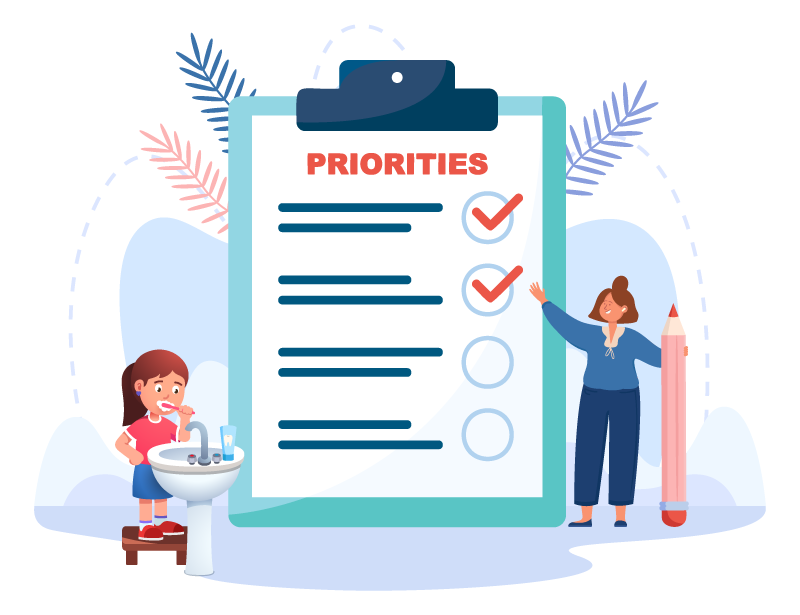
Every day, we engage in hygienic activities to care for our bodies, from bathing and washing our hands, to brushing our teeth. Our ability to keep up with these activities has both short and long-term effects on our physical health, mental well-being, and social interactions.
However, as the parents and caregivers of children with Autism Spectrum Disorder (ASD) know all too well, there are significant challenges that come with teaching and encouraging good hygiene habits.
Why are Good Hygiene Habits Difficult to Form

The difficulty caregivers for those with ASD face can arise for a variety of reasons, including, but not limited to,
- A child’s intolerance for various types of sensory input
- A child’s difficulty communicating the reasons that hygiene tasks are aversive
- A child’s lack of the prerequisite skills
- A child’s persistent deficits in socialization
For example, when brushing your teeth, there are physical and mental sequences of steps to complete, while also tolerating the tastes, sounds, and smells from the toothbrush and toothpaste. This is difficult!
Some children can verbally express what they like, don’t like, can, and cannot do, allowing the caregiver a window into a greater understanding of the barriers involved for their child, and a starting point for areas to work on. However, if a child cannot or will not verbally express these barriers calmly, they may instead engage in intense non-compliance to avoid hygiene activities altogether. This can then leave you feeling frustrated with the daily stress of toothbrushing, and anxious about the consequences of poor hygiene habits.
Furthermore, because ASD is characterized by persistent socialization deficits, the social benefits of good hygiene may not be apparent, relevant, or motivating enough to a child to outweigh the aversiveness of these tasks.
Most of us brush our teeth because we don’t want painful cavities that require drilling and filling, but we also brush our teeth so we’re not embarrassed by bad breath. But does your child care about that?
Most of us consciously wash our hands because we want to avoid germs. But we also don’t want to be that person in the public restroom that skips washing their hands to the horror of other bathroom users. But does your child care about that?
Where To Start
How do we go from meltdown to successful hygiene habits? As you can imagine, there isn’t a one-size-fits-all approach and there are a lot of factors to consider, but there are simple starting points and strategies that any caregiver can apply to begin teaching more successful hygiene behaviors.
- Prioritize
- Create, and build consistent behaviors through Task Analysis
- Model the Behavior
- Provide Positive Reinforcement

First, decide which activities are most important and in need of skill acquisition. Don’t try to teach every hygiene skill at once. This will only result in unneeded stress for everyone. By selecting the most important skill you will allow the child to truly focus on building the individual skills needed to complete a hygiene task successfully. Pick one or two hygiene skills to start.
Once you’ve identified a skill to teach, think about how YOU do the process. For example, go brush your teeth, and write down every single step that you do. Pay attention to the details, like removing the cap from the toothpaste. This is how you create a task analysis.
Task analysis takes a lot of practice to get right and the task analysis for the same skill can be different depending on a person’s needs, and what prerequisite skills they have already developed. This can also be a time where assistance from your BCBA (Board Certified Behavior Analyst) can come in handy. BCBAs who are thoroughly trained in Applied Behavior Analysis, create task analyses all of the time! A trained BCBA can help you pinpoint the smaller steps that may need to be taught for successful skill acquisition.
After you’ve created your task analysis (or steps), see what your child can and cannot do on their own. For example, hand them a toothbrush and say “show me how you brush your teeth all on your own”, or after they use the toilet say “show me how you can wash your hands.” This will give you an idea of where to start.
Let’s say your child already knows how to put the toothpaste on the toothbrush, and turn the water on in the correct order, but then just stands there. This gives you an idea of which steps you’ll need to remind them to do until they can do them with consistency, as well as which steps need to be taught in the rest of the process.
Next, try modeling the process of doing the task for your child. Meaning, SHOW THEM how you do it. Go through every step you created in your task analysis. Make it fun! Make it exciting! And more than anything, don’t make it stressful.
Then, when it is time to do the activity each day, remember to include a ton of positive reinforcement. Try to break out the little steps that they cannot or will not do and teach them in isolation. So, if they can’t put toothpaste on the toothbrush, practice just that part a bunch of times every day. If they’ll do everything besides scrub their teeth with the brush, practice just putting it closer and closer to their mouth, and then to their teeth, little by little each day. And make it a party! Make it silly, put on some music, whatever you have to do to make it non-aversive.

Pro Tips
Practice at a time when you’re not in a rush, not trying to get out the door, at a time when you can focus just on this specific hygiene task and can teach, just to teach.
Create a simple reinforcement system to reward positive behavior and effort towards learning the skills you are teaching. For example, a simple sticker system where the child earns a sticker on a chart after trying to complete each step without demonstrating noncompliance or other maladaptive behaviors. Then the child could earn a prize or activity that they love for receiving a certain number of stickers. Again, you can reach out to your BCBA to help you develop a system that will truly motivate your child to work towards achieving a goal. Reinforcement systems can be extremely effective when developed thoughtfully with your child’s specific skill level and interests in mind.

Overwhelmed?
At this point, many of you may be feeling overwhelmed, perhaps thinking, ”Nope. This would never work in my house”. Or, “It’s just too much, I don’t have the time or patience”. If that’s the case, you are not alone!
Teaching hygiene skills at home is a challenge for SO many of us. But, like so many things in life, start small, with simple and attainable goals.
Reach out to your care team, ask your BCBA to come to your home, and help you learn the tools needed to teach hygiene and other skills to your child. Work with your care team to identify your child’s specific areas of strength and limitations, develop strategies to build their tolerance for aversive activities, and ultimately, acquire the skills to complete a necessary task.
You’ll be amazed at what you and your child can do! The opportunities are endless.
